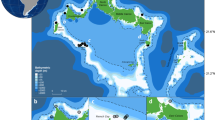Abstract
I report on multiple correlates of reduction in metabolic rate during evolutionary adaptation to caves in the fish family Amblyopsidae. The family includes six species with one surface-dweller, Chologaster cornuta, a facultative cave dweller, Chologaster agassizi, and four obligate cave-dwellers that, on the basis of eye degeneration, have been isolated in caves for increasing times: Typhlichthys subterraneus Amblyopsis spelaea Amblyopsis rosae Speoplatyrhinus poulsoni. Of those traits I examined, the strongest correlates of reduction in whole fishes metabolic rate were reduction in ventilation frequency and volume > brain metabolic rate > gill surface area. Relative amplitude declined and the estimated ventilation minute-volume decreased 5.9 fold from a value of 1.12 to 0.19 ml. Log brain rate of oxygen consumption was directly related to log body mass, b = + 0.75, and decreased from 1.5 to 0.06 μ per mg dry mass per hour among species. No single gill trait accounted for the reduction in total lamellar surface area from 228 to 103 mm2 g−1. There was no reduction in muscle metabolic rate or histological indices of thyroid activity. Log muscle rate of oxygen consumption was inversely related to log body mass, b = −0.60, but did not differ among species. The mean total thyroid follicle volume among species, from 0.010 to 0.020 mm3 g−1 of adult fishes, showed no relation to interspecific differences in whole fish metabolic rate. In the general discussion I show that no trait that could contribute to a lowered metabolic rate is in the same rank order as metabolic rate, though collectively the reductions were in the same order as metabolic rates. I explain that this is as expected with convergent evolution of complex traits. Finally I discuss the literature about central nervous system control of metabolic rate.
Similar content being viewed by others
References
Cooper, J.E. & R.A Kuehne. 1974. Speoplatyrhinus poulsoni, a new genus andspecies of subterranean fishes from Alabama. Copeia 1974: 486–493.
Culver, D.C., T.C. Kane & D.W. Fong. 1995. Adaptation and natural selection in caves: the evolution of Gammarus minus. Harvard University Press, Cambridge, 223 pp.
Eigenmann, C.H. 1909. Cave vertebrates of America, a study indegenerative evolution. Carnegie Inst. Wash. Publ. (104): 1–241.
Ekberg, D.R. 1958. Respirationin tissues of goldfishes adapted to high and low temperatures. Biol. Bull. 114: 308–316.
Gray, I.E.1954. Comparative study of the gill area of marine fishes. Biol. Bull. 107: 219–225.
Horn, M.H.,P. W. Grimes, C.F. Phleger & L.L. McClanahan. 1978. Buoyancy function of the enlarged fluid-filled cranium in the deep-sea ophidiid fish Acanthonus armatus. Mar. Biol. 46: 335–339.
McFarland, W.N. 1959.A study of the effects of anesthetics on the behavior and physiology of fishes. Bull. Inst. Mar. Sci. 4: 23–55
Marshall, N.B. 1960. Swimbladder structure of deep-sea fishes in relation to their systematics and biology.Discov. Rep. 31: 1–122.
Nilsson, G.E. 1996. Brain and body oxygen requirements of Gnathonemuspetersii, a fish with an exceptionally large brain. J. Exp. Biol. 199: 603–607.
Olivereau, M. 1960a.Etude anatomique et histologique de la glande thyroide d’ Uetiglanis zammaranoi, poisson aveugle et cavernicole, comparison avec un Clariidae voison, Clarias bathypogon. Ann. Soc. Roy. Zool. Belg. 90: 99–116.
Olivereau, M. 1960b. Hyperplasie thyroideienne et presence de follicules thyroidiens intra-renaux, chez unexemplaire de Typhlogarra widdowsoni, poisson aveugle et cavernicole de I'lrak. Ann. Soc. Roy. Zool. Belg. 90: 117–125.
Olivereau, M. & M. Francotte-Henry. 1956. Etude histologique de la glande thyroide deCaecobarbus geertsi. Ann. Soc. Roy. Zool. Belg. 86: 129–150
Poulson, T.L. 1961. Cave adaptationin amblyopsid fishes. Ph.D. Dissertation, U. Michigan Microfilms 61–2787. 185 pp.
Poulson, T.L. 1963. Caveadaptation in amblyopsid fishes. Amer. Midl. Nat. 70: 257–290.
Poulson, T.L. 1964. Animals inaquatic environments: animals in caves. pp. 749–771. In: D.B. Dill (ed.) Handbook of Physiology: Environment, Amer. Physiol. Soc., Washington, D.C.
Poulson, T.L. 1971. Biology of cave and deep-seaorganisms: a comparison. Bull. Nat. Speleol. Soc. 33: 51–61.
Poulson, T.L. 1985. Evolutionaryreduction by neutral mutations: plausibility arguments and data from amblyopsid fishes and linyphiid spiders. Bull. Nat. Speleol. Soc. 47: 109–117.
Prosser, C.L. 1967. Mechanisms of temperature acclimation in fishes. pp.375–409 In: A.S. Troshin (ed.) Cell and Environmental Temperature, Pergamon Press, London.
Rosen, D.E. 1962. Comments on the relationships of the North American cave fishes of the family Amblyopsidae.Amer. Mus. Novitates No. 2109: 1–35.
Vernberg, I.F. 1954. The respiratory metabolism of tissues ofmarine teleosts in relation to activity and body size. Biol. Bull. 106: 360–370.
Vernberg, I.F. & I.E. Gray. 1953. A comparative study of the respiratory metabolism of excised brain tissue of marine teleosts. Biol. Bull. 104: 445–449.
Wilkens, H. 1985. The evolution of polygenic systems, studied on epigeanand cave populations of Astyanax fasciatus (Characidae, Pisces). Bull. Nat. Speleol. Soc. 47: 101–108.
Woodhead, A.D. & S. Ellet. 1967. Effects of food-restriction on thyroid activity in the guppy, Lebistesreticulatus (Peters). Exp. Geront. 2: 49–56.
Woods, L.P. & R.F. Inger. 1957. The cave, spring,and swamp fishes of the family Amblyopsidae of central and eastern United States. Amer. Midl. Nat. 58: 232–256.
Author information
Authors and Affiliations
Rights and permissions
About this article
Cite this article
Poulson, T.L. Morphological and Physiological Correlates of Evolutionary Reduction of Metabolic Rate among Amblyopsid Cave Fishes. Environmental Biology of Fishes 62, 239–249 (2001). https://doi.org/10.1023/A:1011821107820
Issue Date:
DOI: https://doi.org/10.1023/A:1011821107820




